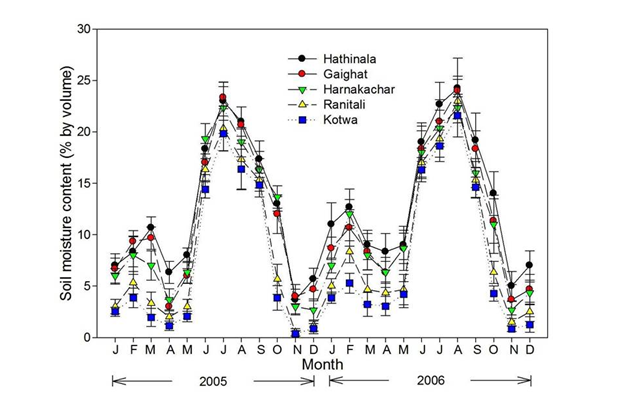International Journal of
eISSN: 2576-4454


Opinion Volume 2 Issue 1
1Community Ecology and Conservation Group, Center for Integrative Conversation, Xishuangbanna Tropical Botanical Garden, Chinese Academy of Sciences, China
2Institute of Environment and Sustainable Development, Banaras Hindu University, India
Correspondence: Chaturvedi RK, Community Ecology and Conservation Group, Center for Integrative Conversation, Xishuangbanna Tropical Botanical Garden, Chinese Academy of Sciences, Chinese Academy of Sciences, Menglun, Mengla, Yunnan 666303, China, Tel +86 18288059250
Received: November 02, 2017 | Published: January 9, 2018
Citation: Chaturvedi RK, Raghubanshi AS. Soil water availability influences major ecosystem processes in tropical dry forest. Int J Hydro. 2018;2(1):14-15. DOI: 10.15406/ijh.2018.02.00042
Tropical dry forests experience a long annual dry season therefore soil moisture availability is the predominant determining factor for the ecosystem processes in such forest types. The seasonal rainfall gradients and the availability of soil moisture have been observed to be highly associated with the distribution, diversity and primary productivity of plant communities in tropical dry forest. The soil moisture availability exhibits significant spatial heterogeneity which is responsible for the interspecific differences in the important components of resource use strategies, like leaf phenology and the function of water conducting xylem tissues. We observed seasonal variation in the soil water availability in tropical dry forest located in Vindhyan highlands, India. The results indicated significant seasonal and site wise variations in soil moisture content. We suggest that for proper management of the tropical dry forest vegetation, it is necessary to understand the major ecosystem processes influenced by the soil moisture conditions.
Keywords: tropical dry forest, soil moisture content, resource use strategies, phenology
Variation in soil moisture content (SMC) and nutrient availability leads to significant changes in the structure and function of the forest ecosystems.1,2 The seasonal rainfall gradients and the availability of soil moisture have been observed to be highly associated with the distribution, diversity and primary productivity of plant communities in tropical dry forest.3−15 Tropical dry forests are the predominant type of vegetation and globally represent second most important tropical forest; the diversity of various kinds of life forms in these ecosystems is considered to be highly influenced with water and nutrient availability.16 Along with a long annual dry period, disturbances such as browsing by domestic cattles and harvesting by humans usually results in an immediate decline in biodiversity and the associated process of regeneration.17−19 In tropical dry forests, the soil moisture availability exhibits significant spatial heterogeneity which is responsible for the interspecific differences in the important components of resource use strategies, like leaf phenology and the function of water conducting xylem tissues.20 Water accumulated in the tree stem, or stored in the subsoil, buffers the harmful effect of low water availability and helps in the flushing of new leaves during the long dry season.21−25 This suggests that tree water status, is probably the predominant determining factor for the phenology of trees, rather than any other climatic factor in the tropical dry forests. Borchert & Rivera26 have observed that in majority of tree species of semi-deciduous tropical forests, leaf buds usually remain dormant for a long period during the dry season and bud-break is induced when there is increase in photoperiod after the arrival of spring equinox. Bud-break has been observed to be highly synchronous in the conspecific, ‘spring-flushing’ tree species, although few differences within species have also been reported.27 It has been reported that the dry season bud-break and leaf expansion in trees occurs only when they are fully rehydrated,23−28 and the shoot growth rate and the leaf expansion period varies according to differences in the availability of water.24−26 To observe seasonal variation in the soil water availability in tropical dry forest, we selected five forest sites in Vindhyan highlands, India (24º18´07˝ - 25º00´17˝ N, 82º37´38˝ - 83º23´05˝ E). The forest region experiences tropical monsoon climate with three seasons in a year, viz., summer (April-mid June), rainy (mid June-September) and winter (November-February). The site selection was done in a way that they represented a range density of trees and canopy openness.13 The measurement of soil moisture content (SMC) was done at 90 locations, randomly at each site, as percentage by volume every month, at a depth of 10 cm at 1-month intervals for 2 years (i.e. January 2005 to December 2006) using a theta probe instrument (type ML 1, Delta-T Devices, Cambridge, UK). The result of the study showed that across the 12 months in a year, SMC in July and August was higher at all five sites (Figure 1). Lower SMC was observed in November and December. The site wise variation in SMC was not significant only in July, August and September, when the availability of soil water was in plenty. During the dry months site-wise variation in SMC was high, probably due to differences in the water holding capacity of the forest sites.

Monthly soil moisture content at the five study sites from January 2005 to December 2006. (Source).26
Tropical dry forests experience a long annual dry season therefore soil moisture availability is the predominant determining factor for the ecosystem processes in such forest types. For surviving in the water limited environment plants possess various kinds of strategies to make the most efficient use of water. Due to wide spatial heterogeneity in the soil moisture availability, plants exhibit interspecific differences in the resource use strategies. Therefore, for proper management of the tropical dry forest vegetation, it is necessary to understand the major ecosystem processes influenced by the soil moisture conditions.
RKC thanks Council of Scientific and Industrial Research, India (Award no. 09/13(452)/2012-EMR-I) and Natural Science Foundation of China (NSFC), Chinese Academy of Science, China (Grant No. 31750110466) for financial support.
Authors declare there is no conflict of interest in publishing the article.

©2018 Chaturvedi, et al. This is an open access article distributed under the terms of the, which permits unrestricted use, distribution, and build upon your work non-commercially.